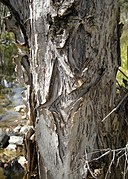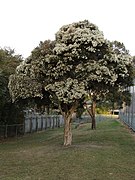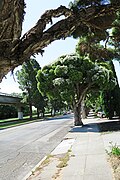Melaleuca linariifolia
| Snow-in-summer | |
|---|---|

| |
| Melaleuca linariifolia | |
| Scientific classification | |
| Kingdom: | Plantae |
| Clade: | Tracheophytes |
| Clade: | Angiosperms |
| Clade: | Eudicots |
| Clade: | Rosids |
| Order: | Myrtales |
| Family: | Myrtaceae |
| Genus: | Melaleuca |
| Species: | M. linariifolia
|
| Binomial name | |
| Melaleuca linariifolia | |
| Synonyms[1] | |
| |
Melaleuca linariifolia is a plant in the myrtle family Myrtaceae, and is endemic to eastern Australia. It is commonly known as snow-in-summer, narrow-leaved paperbark, flax-leaved paperbark and in the language of the Gadigal people as budjur. A hardy plant, it flowers prolifically in late spring or summer, making it a popular garden shrub or small tree in temperate places. Melaleuca trichostachya is a similar species but its leaves are arranged differently and the fruits have projecting valves.

Description
[edit]Melaleuca linariifolia is a small tree growing to a height of 6–10 m (20–30 ft) with distinctive and attractive white or creamy white, papery bark and a dense canopy. Its leaves are arranged in alternating pairs (decussate), glabrous except when very young, 17–45 mm (0.7–2 in) long, 1–4 mm (0.04–0.2 in) wide, linear to lance-shaped and with a distinct mid-vein.[2][3]
The flowers are white to creamy-white, perfumed and arranged in spikes on the ends of branches which continue to grow after flowering, sometimes also in the upper leaf axils. Each spike is up to 40 mm (2 in) wide and long and contains 4 to 20 individual flowers. The petals are 2.5–3.3 mm (0.1–0.1 in) long and fall off as the flower matures. The stamens are arranged in five bundles around the flower and each bundle contains 32 to 73 stamens.
The flowers cover the tree over a relatively short period, between October and February and are followed by fruit which are woody capsules, 2.5–4 mm (0.1–0.2 in) long and 4–5 mm (0.16–0.20 in) long scattered along the stems. The fruiting capsules have valves which do not project beyond the rim of the capsule.[2][3][4]
Taxonomy and naming
[edit]Melaleuca linariifolia was first formally described in 1797 by James Edward Smith in Transactions of the Linnean Society of London.[5][6] Smith noted that "This, we are told by Mr White, is a large tree, the bark of which is very thick and spongy, serving the purpose of tinder." The specific epithet linariifolia means "with leaves like Linaria" (a genus of plants in the family Plantaginaceae).[2][7]
Distribution
[edit]Snow-in-summer occurs from the Maryborough district in Queensland to Bawley Point in the Ulladulla district in New South Wales. There is also a disjunct population in the Blackdown Tableland National Park in Queensland. It is found in heath and dry sclerophyll forest habitats, usually growing near watercourses or swamps.[4]
Uses
[edit]Horticulture
[edit]Melaleuca linariifolia is cultivated as an ornamental tree for parks and gardens and is also used as a screen or windbreak in Australia[8][9] and overseas.[10] It is popular as a nature strip tree in Melbourne in Victoria.[3] It tolerates both dry and boggy conditions and is frost hardy.[3] It should be planted with caution as it can damage wastewater pipes,[11] and is easily ignitable, so should not be planted in fire-prone areas. It has also become a garden escape in Western Australia,[12] it is however suitable for planting under powerlines[13] and is a food or habitat sources for native animals, including many insects.[13]
There is a range of cultivars including dwarf forms such as 'Snowstorm'[14] which grows to a height of 1.5 metres (5 ft), 'Seafoam' at 2.5 metres (8 ft),[8] and 'Claret Tops' at 1.5 metres (5 ft), which features red coloured new growth.[15]
Essential oils
[edit]This species is rich in essential oils, especially Terpinen-4-ol. It has a wider range of tolerance to environmental conditions than the main current source of "tea tree" oil, Melaleuca alternifolia and therefore has potential as an alternative.[2]
Gallery
[edit]-
Specimen in Mount Archer National Park
-
Bark
-
Flowers closeup
-
Tree blooming
-
Flowers emerging
-
In autumn
-
A young specimen
-
Its narrow, spiky leaves.
-
Separate florets removed from the inflorescence, showing long stamens
See also
[edit]- Melaleuca decora, similar looking tree in the same genus
References
[edit]- ^ a b "Melaleuca linariifolia". Plants of the World Online. Retrieved 31 August 2021.
- ^ a b c d Brophy, Joseph J.; Craven, Lyndley A.; Doran, John C. (2013). Melaleucas : their botany, essential oils and uses. Canberra: Australian Centre for International Agricultural Research. pp. 227–228. ISBN 978-1-922137-51-7.
- ^ a b c d Holliday, Ivan (2004). Melaleucas : a field and garden guide (2nd ed.). Frenchs Forest, N.S.W.: Reed New Holland Publishers. pp. 174–175. ISBN 1-876334-98-3.
- ^ a b Wilson, Peter G. "Melaleuca linariifolia". Royal Botanic Garden, Sydney;PlantNet. Retrieved 4 June 2015.
- ^ "Melaleuca linariifolia". APNI. Retrieved 4 June 2015.
- ^ Smith, James Edward (1797). Transactions of the Linnean Society of London: (Volume 3): Botanical Characters of Some Plants of the Natural Order of Myrti. London. p. 278. Retrieved 4 June 2015.
- ^ Brown, Roland Wilbur (1956). The Composition of Scientific Words. Washington, D.C.: Smithsonian Institution Press. p. 340.
- ^ a b "Melaleuca linariifolia". Australian Native Plant Society, Australia. Retrieved 4 June 2015.
- ^ Wrigley, John W.; Fagg, Murray (1983). Australian native plants : a manual for their propagation, cultivation and use in landscaping (2 ed.). Sydney: Collins. p. 352. ISBN 0002165759.
- ^ "Flaxleaf paperbark". Virginia Tech. Retrieved 4 June 2015.
- ^ "Melaleuca linariifolia". Sydney Water. Retrieved 4 June 2015.
- ^ "Melaleuca linariifolia". FloraBase. Western Australian Government Department of Biodiversity, Conservation and Attractions.
- ^ a b "Melaleuca linariifolia" (PDF). Yarra Ranges Shire Council. Retrieved 4 June 2015.
- ^ "Melaleuca linariifolia 'Snowstorm'". APNI. Retrieved 4 June 2015.
- ^ Melaleuca linariifolia 'Claret Tops'. Botanic Gardens of South Australia. Retrieved 16 February 2020









